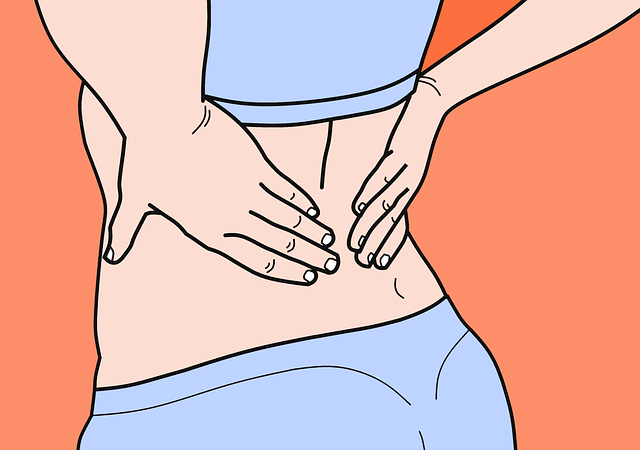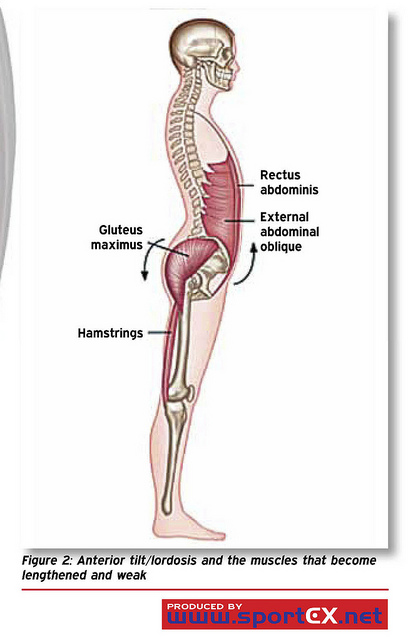Seven Exercises and Extra Tips to Help Prevent, Reduce, Eliminate, and Otherwise Remedy Anterior Pelvic Tilt

Anterior pelvic tilt, or APT for short, is a common postural disorder where your pelvis is tilted forward. If you imagine your pelvis like a bowl full of water, a pelvis with APT would be pouring water out the front.
Note: anterior pelvic tilt is also known as lower crossed syndrome.
Anterior pelvic tilt is a very common condition, especially among those who sit too much. And while it’s not necessarily problematic in-and-of-itself, it certainly isn’t an optimal posture, and could lead to problems down the road (e.g. lower back pain, knee issues, etc.). Fortunately, some simple exercises are often all that is needed to fix anterior pelvic tilt and bring the spine and pelvis back into alignment.
So, how do you know if you have APT?
The most basic assessment would be to look in a mirror and examine your belt-line from the side. If your belt is higher around your back than it is around your belly (i.e. and it “slopes” downward at your sides), you likely have APT. Another sign would be difficulty tucking your tailbone, but easily arching your lower back (e.g. sticking your bum out).
With APT, your hip flexors are tight, your glutes and abs are both weak and loose (i.e. over-stretched), and your lumbar spine is in lordosis.
Here’s a diagram of someone with anterior pelvic tilt.

So, if you’d like to reduce or eliminate your anterior pelvic tilt, you’ll want to focus on a couple of things:
- Strengthen your glutes and abs
- Stretch your hip flexors
Here are some exercises that will help you do just that…
7 Exercises for Anterior Pelvic Tilt
Exercises to Fix Anterior Pelvic Tilt
Standing posterior pelvic tilt – From a standing position with feet shoulder width apart, exhale and tuck your tailbone – flatting out your lower back – as you reach your tailbone as far forward as you can. Squeeze your glutes and contract your core as you imagine pouring water out the back of your pelvic “bowl.”
Lying posterior pelvic tilt – This is the same exercise as above, just done on the floor. Lying on your back with your knees bent and feet flat on the ground (e.g. like the start position for the “sit-up” exercise), exhale and tuck your tailbone – pushing your lower back into the floor – as you contract your core, drawing your belly in.
Cat pose – On hands and knees with back flat, exhale and tuck your tailbone – squeezing your glutes and core (drawing your belly in) – as you press your palms into the floor, allowing your mid-back to lift up and your shoulder blades to slide off your ribs.
Note: The Cat/Cow poses are a good way to learn how to tilt your pelvis forward and backward (i.e. Anterior Pelvic Tilt vs Posterior Pelvic Tilt).
Split-kneeling hip flexor stretch – From a split-kneeling position (i.e. one foot down and one knee down), lengthen your spine and tuck your tailbone forward as you squeeze your glutes until you feel a stretch in the hip flexor muscles on the front of your rear leg.
Note: click here for a more detailed tutorial on the split-kneeling hip flexor stretch (see exercise number 5)
Glute bridge – Lying on your back with your knees bent and feet flat on the ground (e.g. like the start position for the “sit-up” exercise), exhale and press through your feet to lift your hips off the ground, squeezing your glutes until you reach full hip extension (i.e. with a straight line from knees to hips to shoulders). Lower back down under control.
Knee and leg raises – While hanging from a bar or supporting yourself on a set of parallel bars, exhale and raise your knees or legs out in front of you – contracting your core – and pausing in the top position before lowering your legs back down again.
Plank exercises – Resting on your elbows and feet, lengthen your spine, squeeze your glutes, contract your core, and tuck your tailbone, holding this position for time.
Note: Click Here for a detailed tutorial of the plank exercise, and Click Here for a detailed tutorial of the side plank exercise.
Tips to Help Fix Anterior Pelvic Tilt
- Be mindful of your posture throughout the day and remember to tuck your tailbone slightly to restore a neutral spine.
- Be mindful of your structure whenever training, being sure to use proper technique with crown to coccyx alignment.
- Go barefoot or wear zero drop shoes whenever you can (i.e. don’t wear footwear with high heels).
- Spend a training cycle focusing on strengthening your glutes and core.
- Don’t sleep on your stomach, especially if you have a sagging mattress.
Final Words
Even if you don’t have any pain or injuries, correcting a bad case of anterior pelvic tilt is probably worth the effort. And with these exercises, it’s easy to get started and seeing results quickly.
Now, if you have anterior pelvic tilt, chances are you also sit way too much. If that’s true, these exercises will be indispensable: 5 Simple Exercises to Reverse the Damage from Sitting in Only 5 Minutes a Day.
If you found this article helpful, please share it with your friends:
.jpg)
![]()
Health-First Fitness Coach
P.S. If you liked this post, then please signup for the newsletter, or follow me on Facebook or Twitter for daily updates and other interesting info.
Photo credit: 1.

Thank you for your site & all the time you have put towards educating the average person on how to live your best & healthiest life. I have struggled with lower back problems almost my whole life & when I read your article about APT it all rang so true. I have been working on my planks, pull-ups & push-ups using your techniques & have worked up to a 3:30 minute plank. Im only on a 45 second deadhang but my goal is 1 unassisted pull-up by the end of the year. I am more knowledgeable & on my way to a healthier & stronger me. Thank you!!!
It’s my pleasure, Roxanne. Thanks for the kind note. Please let me know if there’s anything I can do to help you achieve your fitness goals. And well done on the plank training. If you apply the same diligence to your pull-up training, I suspect you’ll get that first pull-up sooner than you think.
Can a sagging soft mattress cause lower back pain?
Hi there,
I really enjoyed your article and will be following this thoroughly. My question is…. after doing this routine, how will I know when it is time to start working out and what exercises should I be implementing with this condition? Furthermore, how will I know if a specific exercise is or is not beneficial for a forward tipped pelvis?
Thank you so much for your time,
Tania Benoit
Is Runner’s Lunge safe to do as it also stretches hamstrings because for apt hamstrings should be strengthened not stretched